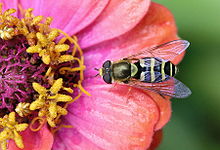- Eupeodes americanus
-
Eupeodes americanus 
Scientific classification Kingdom: Animalia Phylum: Arthropoda Class: Insecta Order: Diptera Family: Syrphidae Genus: Eupeodes Species: E. americanus Binomial name Eupeodes americanus
Wiedemann, 1830Synonyms - Syrphus americanus Wiedemann, 1830
- Syrphus canadensis Curran, 1926
- Syrphus lebanoensis Fluke, 1930
- Syrphus medius Jones, 1917
- Syrphus wiedemanni Johnson, 1919
The American hover fly, Eupeodes americanus, is found throughout North America and inhabits meadows, and fields with flowers and foliage. Adult American hover flies feed on nectar, whereas their larva feed on aphids. The adult fly is black to metallic green, and has 3 yellow bands on its abdomen. Its face is yellowish but with black cheeks, and its wings are clear, it is 9–12 mm in body length.[1] The Larvae are mature at around 11mm, They are yellow-white to salmon brown, with markings of black and white or yellow-white. The lighter markings consist of a transverse rectangular bars on segments 6 to 11, and a narrow line along each side of the larvae. Early instars have visible black setae. The larvae is an active feeder. They are being considered as suitable biological control agents for aphids and scale insects.[2]
References
- ^ Milne, Lorus; Margery Milne (2000). National Audubon Society Field Guide to North American Insects & Spiders. Alfred A. Knopf. ISBN 0-394-50763-0.
- ^ Bugg, Robert L.; Colfer, Ramy G.; Chaney, WiLLiam E.; Cannon, James (2008). "Flower Flies (Syrphidae) and Other Biological Control Agents for Aphids in Vegetable Crops" (PDF Adobe Acobat). ANR Publication (Oakland, California: University of California, Division of Agriculture and Natural Resources) Publication 8285: 1–25. http://ucanr.org/freepubs/docs/8285.pdf. Retrieved 2009-09-27.

This article related to members of the insect family Syrphidae is a stub. You can help Wikipedia by expanding it.

